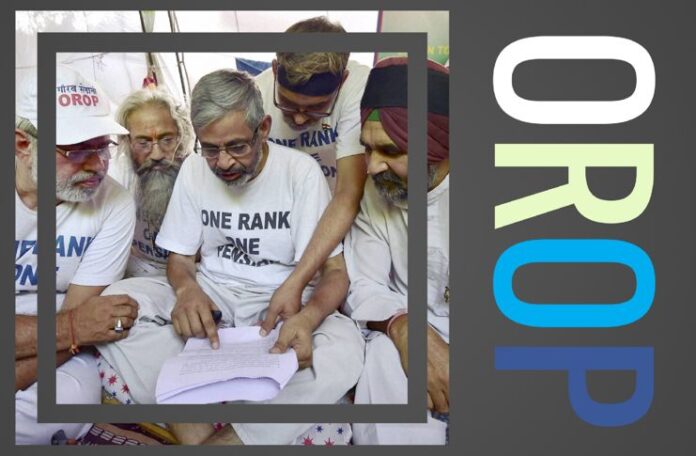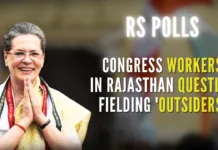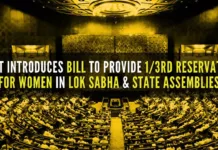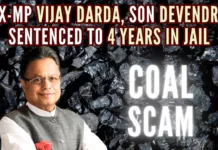
[dropcap color=”#008040″ boxed=”yes” boxed_radius=”8px” class=”” id=””]W[/dropcap]hen the festive Diwali spirit was ending last week, one was between tears and laughter. For full three days, almost every TV channel showed the antics of Rahul Gandhi in Delhi over the death of Ram Kishan Grewal, 70, a Subedar in our Armed Forces who allegedly committed suicide because he was denied the benefit of the OROP (One Rank One Pension) scheme. A Congress crowd was in full throat support of its “Young” Turk popularly called Pappu. In tow was the self-confessed anarchist named Arvind Kejriwal, who cannot live without abusing the nation’s Prime Minister.
The very first thing it (Congress) did with OROP was … abolish it!!
What brought the laughter was that Pappu called the OROP as a Congress concept borrowed by BJP for implementation. What brought laughter was the TV sound bite of several BJP persons that the Congress was criticizing their party for its OROP initiative when the Congress itself had done “absolutely nothing about it for the last 43 years.” That this issue affecting lakhs of our military forces was not analysed in TV debates and op-ed articles also brought smiles and sadness.
History shows that it is totally wrong to say that “The Congress did absolutely nothing” about OROP. The reality is that the Congress party actually did so very much about the OROP.
The very first thing it did with OROP was … abolish it!!
In 1973, the Indira Gandhi Congress terminated the “One Rank One Pension” basis for deciding pension of Indian Armed Forces Personnel “which had been in vogue for 26 years since independence” through an ex parte administrative order. A couple of references are cited below:
- One Rank One Pension Report (paras 10.4 and 11.2) and
- Stop misleading the people with arithmetic.
[dropcap color=”#008040″ boxed=”yes” boxed_radius=”8px” class=”” id=””]I[/dropcap]n addition, the Government, acted on the bureaucrats-dominated Third Pay Commission Report and increased the pension of civilians from 30 to 50 per cent while reducing the pension of soldier, Non-Commissioned Officers and Junior Commissioned Officers from 70 to 50 percent of basic pay, with the caveat that for full pension the minimum service was 33 years. But as soldiers in 1973 retired after 15 years service, at the age of 33-36, they got less than 30 percent of the pay as pension. Soldiers’ pension was thus, in effect, decreased from 70 to 30 percent.
In 1986, the prevalent unease and distrust was exacerbated by the Congress government of Rajiv Gandhi.
Further, apart from lowering the military pensions, the government, without assigning reason, downgraded the status of soldier by equating “infantry soldier with less than three years’ service” with a “semi-skilled/ unskilled labour”. Shockingly, these decisions were based on the endorsement of a Defence Secretary who was a product of the British rule and whose job it was to ensure the well-being of the armed forces.
So, who says the Congress did not do anything on OROP?
In 1986, the prevalent unease and distrust was exacerbated by the Congress government of Rajiv Gandhi. It implemented the Fourth Pay Commission’s recommendation of “Rank Pay”, which reduced basic pay of of certain ranks (From Captain right up to Brigadier and their equivalent in the Air and Naval forces) relative to basic pay scales of civilian and police officers. This reduced the basic pay of these ranks, implemented without consulting the armed forces, created radically asymmetries between ranks; it affected the pay and pension of tens of thousands of officers and veterans. It also spawned two decades of litigation by veterans. It continued distrust between the armed forces veterans and the Defence Ministry which the government did little to remove.
[dropcap color=”#008040″ boxed=”yes” boxed_radius=”8px” class=”” id=””]I[/dropcap]n 2008, the Manmohan Singh-led United Progressive Alliance government, in the wake of the Sixth Central Pay Commission, discarded the concept of “Rank Pay”.
This sordid attempt to buy the silence of the Chiefs of the armed Forces on an issue that affects the entire officers’ class did not go down well with veterans.
But he did something worse.
Even though OROP was not a transparently stated civil service or police officers’ demand, the “mum” PM rewarded senior civil servants and IPS officers with OROP at the apex government scale. The decision to grant ‘OROP’ to the senior most government servants was taken, not by parliamentary or ministerial committee, but by Pensions Department bureaucrats and the PMO. It is believed that the decision to grant OROP-2008 to the civil and police services was implemented not by public notification, but by a cunningly worded internal memorandum issued by the relevant pensions department under the PMO. As ‘Apex-OROP’ was done secretly it remained little known, and only gained salience after the veterans started their protests. So, can it be sad that the Congress did “nothing” on OROP?
‘Apex-OROP-2008’ covers thousands of retired, serving and future Civil Service officers, (numbering some 11,000 in the cadre structure) are guaranteed that they will retire at the apex scale, notwithstanding what their responsibilities or duties entail.
In contrast to almost hundred per cent Apex-OROP coverage to past and future retiree from the civil services, including majority of defence civilian like accounts and audit, land, only 10 per cent of the armed forces officers were also included in the Apex OROP scheme — possibly as a hedge against their opposition to the scheme. While the three Defence Chiefs were included along with a few Lt. Generals, and their equivalents in the Navy, and Air Force, those excluded were Lt. Generals, Major Generals, Vice Admirals, Rear Admirals, and Air Marshals.
This sordid attempt to buy the silence of the Chiefs of the armed Forces on an issue that affects the entire officers’ class did not go down well with veterans.
[dropcap color=”#008040″ boxed=”yes” boxed_radius=”8px” class=”” id=””]S[/dropcap]oon, therefore, this deceit of the Congress became an additional causus belli for the Armed Forces veterans protest over OROP. It was also the probable cause for the unprecedented letter by former Chiefs of our Defence to the Government declaring their support for an OROP for them.
However, the unrest of the war veterans was becoming too suffocating for the Congress in power.
A sinister question arises here. Did Manmohan Singh do all this above in 2008 “under cover” machinations as a fulfillment of Sonia Gandhi’s promise in 2002 of an OROP in the Congress election party manifesto of the 2004 poll? Was Apex 2008, if successful, to be further modified in the election manifesto of 2009?
However, the unrest of the war veterans was becoming too suffocating for the Congress in power.
Hence, on 7th May 2010, the Parliamentary Standing Committee on Defence strongly recommended grant of OROP to the Armed Forces personnel.
And then, on 15 March 2011, Rajya Sabha Chairman admitted the petition for grant of one rank one pension to the armed forces. On 4 May 2011, a 10-member Committee commenced hearing under the chairmanship of Bhagat Singh Koshyari, a veteran BJP Member of Rajya Sabha.
The Koshyari Committee, after considering the evidence and oral depositions for eight months, submitted its report in December 2011. It strongly recommended its implementation.
[dropcap color=”#008040″ boxed=”yes” boxed_radius=”8px” class=”” id=””]T[/dropcap]he Committee made it crystal clear that “OROP” implies that uniform pension be paid to the Armed Forces Personnel retiring in the same rank with the same length of service irrespective of their date of retirement and any future enhancement in the rates of pension to be automatically passed on to the past pensioners.” This definition of OROP was accepted by the Government.
In contrast, the present NDA government has provided around Rs 10,000 crores ($1.49 billion), of which it has already disbursed about Rs 5,500 crores ($818 million) to the Banks…
On February 27, 2014, a PTI report said “The Defence Ministry has issued the orders for implementing OROP for ex-servicemen from April 1, a Defence Ministry spokesperson said.”
As evidence of its ignorance of the scope and complexities of this historical OROP proposal of the Koshyari Committee of December 2011, the Congress-led UPA government announced on 24th September 2012 that it has approved OROP, and has set aside Rs 2,300 crores ($342 million) for it. And, surprise, surprise, in its last Budget for Financial year 2014-15, it provided for… Rs. 500 crores ($74 million) for OROP!
In contrast, the present NDA government has provided around Rs 10,000 crores ($1.49 billion), of which it has already disbursed about Rs 5,500 crores ($818 million) to the Banks and has taken the consent of senior Armed Forces officers to disburse the entire amount in installments — as publicly announced by the PM himself to a section of our Armed Forces in Himachal Pradesh on Diwali day. This sum of around Rs. 10,000 crores ($1.49 billion) is in keeping with what, Vir Chakra Colonel Anil Kaul (retired) had estimated in an article of August 2015. He believed that potential beneficiaries of OROP are about 2.6 million ex-servicemen, and 60,000 widows, including war widows, i.e., a combined total of 3.2 million, of whom about 86 percent are widows, JCOs, NCOs, and other ranks, about 14 percent are officers. Out of the estimated outlay on OROP of Rs 8400 crores ($1.25 billion), about Rs. 6200 crores ($922 million) will be on account of widows, JCOs, NCOs, and other ranks.
Clearly, the Congress Party’s record on the OROP scheme was hypocritical and shameful all along. It simply played with it all the time. To say that the Congress had done “nothing” about the OROP in the last 43 years is a joke that brings laughter till tears roll out. After all, it had, to repeat, only played with it.
It was in this frivolous approach that Pappu Gandhi dubbed the suicide-committing, long-retired Subedar Grewal as a “martyr”. That’s how you react when you don’t see, on TV, a retired Army Chief saying that a soldier never commits suicide. That’s how you react also when you don’t look up the Oxford Dictionary to know that a “martyr” is “a person who is killed because of their religious or other belief”. Since the late Grewal (RIP); perhaps the late Grewal (RIP) was agitating only for an addition of Rs. 5,000 ($74) to his existing drawn pension of Rs. 24,999 ($372) what fits him is the second Oxford meaning of “martyr” as “a person who displays or exaggerates their suffering or discomfort in order to obtain sympathy or admiration”. TV channels may kindly note that subtlety, and decide to use the “martyr” word only for those who go from the battlefield to the war grave. That way, viewers would be spared their laughter and remain only with tears.
Note:
1. The conversion rate used in this article is 1 USD = 67.25 Rupees.
2. Text in Blue points to additional data on the topic.
- To Editors’ Guild; May we also have our say… please? - July 17, 2019
- Farooq Sahab is either down with dementia or he is a congenital liar? - July 8, 2019
- Shah Bano, Muslims in gutter &Zakaria’s secularism - June 30, 2019











For Congress Party OROP Means ” Only Rahul Only Priyanka”.
The article is breft of facts, which are very clervily hidden. The OROP to veterans is being propagated by the present Govt as a great deal of favour to retired defence personnel where as, facts are quite contrary. In fact what has been given to veterans is One Time Increase and not the actual OROP, as was envisaged in Koshyari Committee report which was adopted by the Parliament. If actual OROP would have been granted then there was no need for veterans to return to Jantar Mantar to intensify 2nd fase of peaceful agitation for sanction of full OROP. The writer appears to be a hard core sympathiser of BJP.
Facts are with half truths . bias and tilt ( charchagiri in journalism ) is visible.
OROP is evolutionary.This is delayed so long ,because the military suffering was submerged on their great spirits of sacrifice for the Nation with feelings of discipline.
A stage has reached to limits of acceptance and sacrifices.
The tide and trend is beyond further delay & control.
What is ushered ( leave aside those figs to hide truth of truthful orop ), after so much of delay ,even after specific resolutions in parliament ( a law ) ,before Bihar elections ,is only a – diminished orop ,- truncated orop – enhancement of pension at 2013 level and not at 1.1.2016 level ,-a sort of one time increment awaiting resolution after OMJC .
Every political party evaded the issue with neta-babu babu nexus for so long .still being evaded.
Post 6 & 7cpc all civil service employees of goi are simply receiving orop pensions without any controversy. Post 7 CPC ,on 1.1.2016 and beyond ,military lost parity .resulted in further disparity.
Wait and see ,disparity to surface as days are passing by.
Final count will surface for resolution and proper OROP.
Wait and see developments for truthful orop.
A veteran is one who, at some point in his life, writes a blank cheque payable to India, upto and including his life.
Can any govt repay this? It can at least restore the respect of the veteran.
The present govt too does not understand this; else jantar mantar agitation would have not continued.